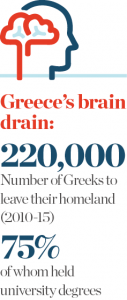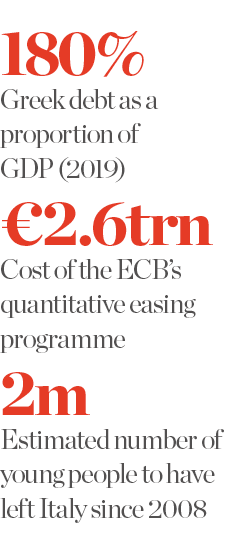
The legacy of the Great Recession and the subsequent sovereign debt crisis casts a long shadow over Europe. It took eight years for the eurozone’s economy to surpass its pre-crisis high and a further three for investment in the EU to return to 2007 levels. “The wind is back in Europe’s sails,” boomed then European Commission President Jean-Claude Juncker in 2017. But where is it sailing?
By the end of 2018, the European Central Bank (ECB) had spent €2.6trn as part of its quantitative easing programme, only for it to restart the process in 2019. With economic headwinds inbound, the countries most vulnerable today are the same ones that suffered the most 10 years previously.
Such is the fear of a further brain drain in Southern Europe that emigration is considered a greater threat than immigration
Dubbed the PIGS (Portugal, Italy, Greece and Spain), these countries still bear the scars of the last crisis. Today, the GDP per capita of all four economies remains below pre-crisis levels – populations are ageing and workforces have shrunk. And while unemployment is falling, it remains high. Net migration in the region has turned positive, but whether this is an aberration or part of a longer-term trend will be determined by the policy decisions of the individual countries and the EU.
A mass Grexodus
During the sovereign debt crisis, unemployment drastically increased across the PIGS. Between 2007 and 2013, unemployment rates in Greece and Spain tripled to 27.8 percent and 26.3 percent respectively. While Italy and Portugal didn’t experience quite such a shock, unemployment rates still almost doubled in both countries.
Since 2014, though, unemployment has been falling gradually. In Greece, it dipped below 20 percent for the first time in six years in 2018, while the other three countries have slowly edged closer to the eurozone average of 7.5 percent. But falling unemployment is a very small subset of a much wider picture: currently, Southern European countries are still dealing with what Dr Theodoros Papadopoulos, a lecturer in comparative social policy at the University of Bath, calls a “grand middle-class exodus”. 
“One of the key factors behind this drop in unemployment is that a lot of young people left the Southern European countries to find jobs elsewhere,” Papadopoulos told European CEO. “Anyone who was well-educated left their countries, which caused a brain drain in the region”.
In Greece, where the worst brain drain occurred, more than 220,000 citizens – equivalent to roughly one member from every 18 families – left their homeland between 2010 and the first four months of 2015. Of these emigrants, 75 percent held university degrees and, by mid-2016, only 15 percent had returned. According to a 2018 research paper published by the London School of Economics, those who were highly educated were the least likely to return.
This negative correlation was reflected elsewhere in Southern Europe, but nowhere more so than in Italy: around 160,000 Italians moved abroad in 2018 (the largest number since 1981), bringing the total number of young and mostly skilled Italians to have left the country since 2008 to roughly two million. According to the Financial Times, this exodus has created a lopsided demographic, with nearly 23 percent of the population now aged 65 or over – the second-highest proportion of over-65s globally, behind Japan. Inevitably, this burgeoning dependency ratio has put Italy’s public purse under strain, with pension costs as a share of GDP the second-highest among the 37 OECD countries, after Greece.
Such is the fear of a further brain drain in Southern Europe that emigration is considered a greater threat than immigration. An opinion poll taken by the European Council on Foreign Relations before the 2019 European parliamentary elections found that support for preventing nationals from leaving their country for long periods was highest in Spain (62 percent), Greece (59 percent) and Italy (51 percent). By comparison, the EU average was 32 percent. While Hungarian Prime Minister Viktor Orbán prophesied the elections would be determined by immigration, he failed to consider the flip side of the debate.
The kids aren’t alright
Youth unemployment is still extremely high in Southern Europe. Across Italy, Greece and Spain, youth unemployment rates remain stubbornly between 30 and 40 percent. When the effects of the recession started to take hold, youth unemployment exploded. In Greece, the rate ballooned from 21.9 percent at the start of 2008 to 59.5 percent by the start of 2013. Spain followed a similar trajectory and, although less pronounced, so did Italy and Portugal.
The traditional family welfare model had been shattered in Southern Europe, and little effective response, at either a national or supranational level, was provided
It is true that between 2013 and 2018, youth unemployment declined faster than total unemployment in Greece and Italy. And although there is a more noticeable persistence of youth unemployment in Spain and Portugal, this is partially attributable to the faster rate of decline in general unemployment. It is also true that youth unemployment in these countries was high before 2008, but the degree to which these points minimise the severity of the broader youth unemployment crisis in the region is negligible.
In any case, something far more pernicious was unleashed during this period. In Southern Europe, the traditional family welfare model – whereby the household centres on a breadwinner, typically the father – began to disintegrate. According to Papadopoulos, unemployment “struck to the core” of the labour force, and the breadwinner was subsumed into it. “[Previously, the young] could wait to find a good job and did not have the same kind of pressure to leave home… [as those] in Western Europe,” Papadopoulos said. “But they could no longer do this when their fathers found themselves out of work”.
As net household incomes dropped, poverty rates skyrocketed. Today, more than a decade on from the crisis, the PIGS still have some of the highest poverty rates in Europe. According to Eurostat, the at-risk-of-poverty rate was 23 to 35 percent of the total population of each country in 2017. Furthermore, Papadopoulos’ research shows that the number of children aged 17 and under living in jobless households almost doubled across the PIGS between 2010 and 2015, while involuntary part-time employment (those who want to find full-time work but are unable to) increased substantially in the same period.
All of these factors created a climate that was hitherto unknown to Southern Europe: the traditional family welfare model had been shattered, and little effective response, at either a national or supranational level, was provided.
One step forward, two steps back
To understand the current state of the PIGS, it is important to remember that each country was drawn into crisis for entirely different reasons. The collapse of Spain’s construction industry was largely at fault for the country’s economic downfall, while in Italy, the crisis fit into a longer-term deceleration that was already well underway. Portugal escaped from the crisis the least scathed, as its fiscal issues were not as severe as those in Greece, which saw its economy contract by a quarter.
“When Greece got into the eurozone between 1996 and 2000, [it] made tremendous reforms in order to fulfil the entry criteria,” Alexander Kritikos, Research Director at the German Institute for Economic Research, told European CEO. “After they entered, this willingness to engage in further reforms – like structural reforms to the labour market, for instance – were withdrawn and the business climate deteriorated.”
Matters came to a head in 2009, when former Greek Prime Minister George Papandreou declared that the country’s budget deficit was double previous estimates. “When it broke down in 2009, it became clear that Greece was a completely over-regulated country with a strong public deficit,” Kritikos added. 
While the PIGS’ responses to the crisis were markedly different, critics to this day are quick to exhaust familiar tropes about bloated public sectors, generous unemployment benefits and the less-than-optimal working habits of Southern Europeans. This school of thought persists in spite of the fact that each country enacted reforms soon after the crisis, cutting unemployment benefits – such as severance pay and wage freezes – and dismantling employment protection regulations.
Southern European countries thus made their rigid labour markets more malleable in the hope that unemployed citizens would be incentivised to take low-paid jobs and increase their work rate. In turn, it was believed that this would have an expansionary effect on economic growth and employment as production costs fell. But labour market relaxation did not result in falling unemployment: instead, the decline in wages was merely exacerbated by the aggregate drop in demand.
According to Kritikos, labour market rigidity is not the underlying problem. Rather, he cites byzantine regulatory systems, an unpredictable tax environment and weighty bureaucracies as the root causes: “It can take years to enforce a contract, and applying for a licence can take years, if not decades.” He added that these are problems pertinent to Greece and Italy in particular, as their Iberian counterparts were much swifter to implement reforms to their regulatory and labour environments.
Kritikos believes this explains why Spain is currently a more attractive investment destination than Italy. According to the United Nations Conference on Trade and Development’s World Investment Report 2019, Spain became the ninth-largest host for foreign direct investment inflows globally in 2018, with investment into the country reaching $44bn (€39.7bn). Italy, by contrast, received just $24bn (€21.6bn) in 2018.
Bringing owls to Athens
Many European countries had huge government debts when the sovereign debt crisis struck, but Greece fared the worst. Its debt as a proportion of GDP, which was 159.6 percent in 2012, invited a heavy-handed response from the EU, ECB and International Monetary Fund (IMF), known collectively as the European troika. In exchange for three financial packages totalling €289bn, Greece was forced to accept the draconian austerity measures imposed by the troika. These measures included a host of new reforms, such as pension reductions, tax increases and public sector pay freezes.
It was not until 2018 that, for the first time in a decade, Greece was weaned off financial assistance. The debt relief deal announced by the EU in the same year gives Athens more time to repay the €96.9bn worth of loans it owes the bloc and extends Greece a grace period, during which it will pay little or no interest. In return, the country must run a primary surplus (before interest payments) of 3.5 percent of GDP every year until 2022, and of 2.2 percent on average until 2060.
But given that Greek debt as a proportion of GDP is currently 180 percent, growth remains anaemic and output is nearly a quarter below its 2007 level, this deal may not be the “momentous moment” that former Greek Finance Minister Euclid Tsakalotos characterised it as. Greece ranks 72nd out of 190 countries in the World Bank’s Doing Business 2019: Training for Reform report, and investment in the country is low.
Falling short of ‘Grexit’, Greece has a very limited scope for manoeuvre as a eurozone economy. For one, the current centre-right government wants to reduce taxes as a means of stimulating demand, but this proposal risks jeopardising its primary surplus deal with the EU. In the past, it might also have been able to devalue its currency to make its exports or tourism industry more attractive, but this cannot be achieved inside the EU architecture. That, Papadopoulos believes, is the core problem of the sovereign debt crisis: “Unless something is solved at a European level, I don’t see how [Greece] can make a full recovery.”
With or without EU
Demonisation of the EU took many different forms during the sovereign debt crisis, but beyond the ugly propaganda campaigns that appeared across the continent, a more sinister ramification in Southern Europe has been the decline in public trust. According to Papadopoulos, popular trust in the parliaments of the PIGS fell by at least 15 percent between 2008 and 2013. Spain had the sharpest fall, dropping from 32 percent to a meagre seven. These figures have picked up somewhat since 2013, but it is clear that the crisis left long-lasting damage to the cohesiveness of each society in its wake.
Like her predecessor, new ECB President Christine Lagarde will need to do whatever it takes to revitalise the left-behind countries in the south
In recent years, only one Mediterranean economy has publicly flirted with the prospect of leaving the EU: Italy. For now, the country has cooled on the idea and, elsewhere, public polling shows that Euroscepticism in all four countries is relatively low. “It is a very uncertain future outside of the EU and none of the countries want to take that kind of risk,” Papadopoulos told European CEO. “I think the solution to the problem belongs inside the EU, but through a different economic policy.”
To stimulate their economies, Greece and Italy will have to work in lockstep with the EU. To begin with, the two countries would be well advised to start upheaving and streamlining their existing tax and regulatory environments. These structural reforms, along with a business-friendly bureaucracy, would make both countries a far more attractive place for investment.
Meanwhile, the EU must also be prepared to make radical adjustments to its own rules. A decade of austerity has failed to stimulate either economy and, with unemployment still high, fiscal stimulus – primarily through public investment – is now required. Given the ultra-low interest rate environment, this is an auspicious time to commit to spending.
As Philipp Heimberger’s paper Unemployment in Europe: What Should be Done? highlights, the EU should amend budget rules to allow the costs of public investment to be spread over time (fiscal rules prohibit the bloc from creating a structural deficit). By excluding deficit-financed increases in public capital stock from the EU’s deficit calculation, the bloc can pool public investment into a ‘capital budget’, financed through the issuance of bonds. This financial injection would provide a timely boost to two long-suffering economies.
In 2012, then ECB President Mario Draghi declared that he would do “whatever it takes” to save the euro. He honoured this pledge, but the crisis is yet to be fully resolved. The fate of Europe’s southern economies now depends – in part, at least – on the leadership of new ECB chief Christine Lagarde. Like her predecessor, the former IMF director will need to do whatever it takes to revitalise the left-behind countries in the south. After all, what remains of the goodwill between the EU’s northern centre and southern periphery may not survive another financial catastrophe.

